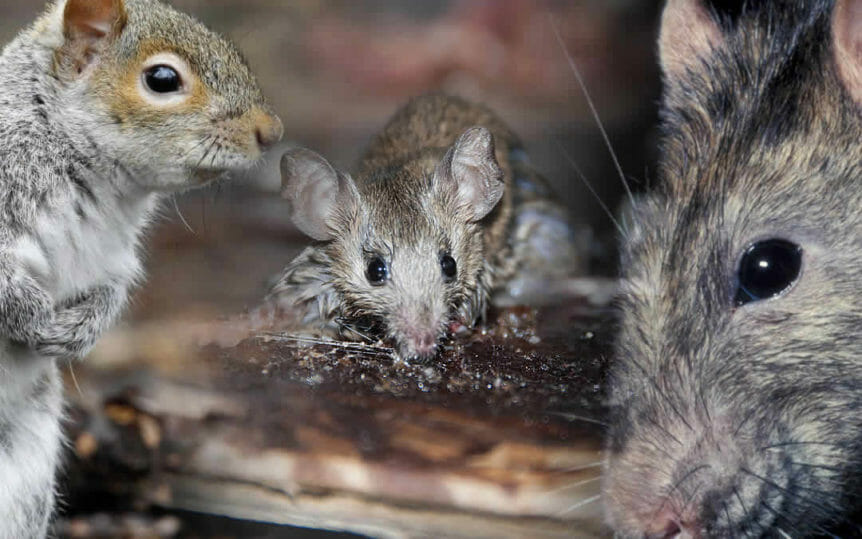
Pests, Not Guests: How to Keep Mice, Rats, and Squirrels Out of Your Home
Share this Post
Hot Houston summers keep us anxiously waiting for beautiful fall weather and cool winter days when we welcome our most treasured guests into our homes for the holidays. But the cooler temperatures also welcome unwanted guests into our homes. Fall is when mice, rats, and squirrels make their way into the comfort of the warm, dark spaces in your house to escape the cold winter ahead.
The thought of mouse droppings on your Christmas platters is horrifying enough, but rodents in your home can have even more serious consequences: infestation, damage to your home that is fairly costly to fix, and diseases that put your family’s health at risk. Let’s take a look at how rodents infiltrate your home, what can happen if they do, and how to get rid of them and keep them out.
How Mice, Rats, and Squirrels Get Into Your Attic and Home
Mice and rats thrive in temperatures between 65°F and 80°F and can actually die from hypothermia if exposed to moderately cold temperatures for an extended period of time. Squirrels have a higher tolerance for colder temperatures but depend on warm enclosures and a high calorie diet for survival. So when it’s 40°F outside, your home is an ideal nesting place for rodents, complete with food and warm shelter. But how do they get in your house?

Squirrels chew holes above gutters and the corners of trim to get into your home. And you may not realize it, but there are also a number of holes outside your home that welcome rodents inside including chimneys, vents, gaps in siding, roof lines, and entry points for wires and pipes. Some mice and rats can even make it through a hole smaller than a quarter. They creep through these holes, crawl up the walls into the attic, and get all snug in their beds. Now, all they need are some sugar plums and holiday stockings to really make themselves at home— and ruin your entire holiday.
Diseases that Mice and Rats Carry
It’s the holiday season, and just like a scene from the Nutcracker, you have no other choice but to ward off the mice that infiltrate your home – along with all the other squatter rodents. Why? Mice, rats, and squirrels carry diseases that can cause both short term and long term illness. Bacteria such as salmonella and listeria found in urine, droppings, saliva, and nesting materials of mice and squirrels can potentially contaminate your home and food causing a range of nasty symptoms: fever, diarrhea, chills, stiffness, and nausea can last for days and sometimes even weeks.

More long term medical concerns include diseases like leptospirosis and lymphocytic choriomeningitis (LCMV) from contact with rat secretions, and lyme disease from squirrels. Lyme disease can be debilitating with symptoms that include fatigue, cognitive impairment, joint pain, poor sleep, mood problems, muscle pain, and neurological complications that can last for more than six months. Leptospirosis and lymphocytic choriomeningitis (LCMV) infections from rats can cause liver damage, kidney failure, pancreatitis, and in some rare cases, meningitis. Bites and scratches by rats can lead to rat-bite fever, which can cause short term flu-like symptoms and long term infection of the heart’s lining, spinal cord, brain, and the lungs, if left untreated. Just think: if rat fleas were blamed for the bubonic plague six hundred years ago, you probably want them out of your home immediately.
You may think the problem is isolated to your attic, but if these sneaky rodents were able to get into your attic, they will find a way to your kitchen, bathrooms, bedrooms, and other parts of your home.
How Mice, Rats, and Squirrels Damage Your Home
Rodents, as small as they are, don’t seem like they are capable of doing much damage to your home. But in reality, these nibblers can contaminate your air ducts and chew holes through piping, which could lead to thousands of dollars in repairs. They can ruin your insulation, cause electrical shortages, and even burn your entire house down; if wire is exposed from rodents chewing on the sheath, and water or urine comes in contact with the wire, your wires could spark and cause a fire.

Rodents can also damage your car and appliances: rats chew through car wires; mice build nests in your appliances; and squirrels chew holes in the exterior of your home to create entry point. And as these rodents breed, your home becomes infested with more disease-carrying creatures. The damage can be exponential.
Speaking of breeding…
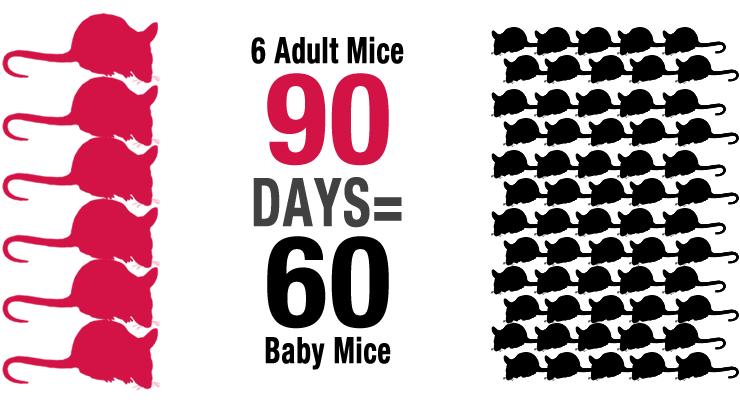
Rodents multiply at alarming rates. A family of 6 mice can grow to 50-60 mice in just 90 days. The gestation period of a common house mouse is just 19 days, 22 days for a roof rat, and 45 days for a squirrel. If you know there’s at least a couple of rodents in your home, you should try to remove them immediately; it probably won’t be long before your home is infestated.
How do I know if there are rats, mice, or squirrels living in my home?
One of the most telltale signs that you have rodents in your home is the scratching and running noise you hear, especially in the evening time when everyone is asleep and your home is quiet.
Signs of Mice in Your House
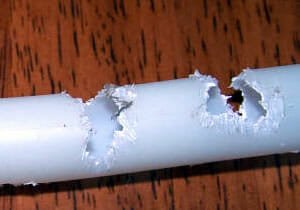
Bite Marks
Check for bite marks on your food packaging, pet food packaging, or containers. Also, you’ll sometimes see these bite marks in pieces of fruit or other food left out overnight. Sometimes, you’ll see traces of crumbs by the mice’s nesting site.
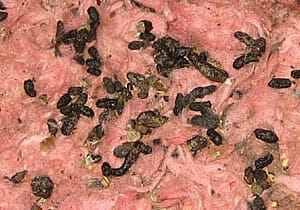
Mouse Feces
Mice go to the bathroom pretty much anywhere, but look for traces of droppings by food sources and warm, dark places like your cabinets and attic. Mice feces are small, oblong pellets that are about 1/32″ in diameter and are pointed at one end.

Track Marks
Because mice have a specific pattern of traffic, you may be able to spot dirt on the wall or tracks in your attic insulation.
Signs of Rats in Your House
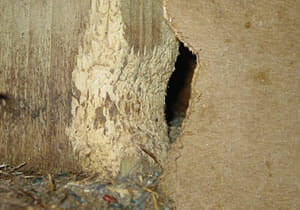
Gnaw Marks
Rats like to gnaw constantly to keep their incisors short, so be on the lookout for gnaw marks on your cabling, insulation, and wood.
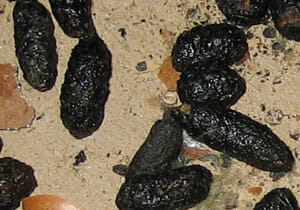
Rat droppings
Pellets about a centimeter long resembling olive pits in size and shape belong to rats.
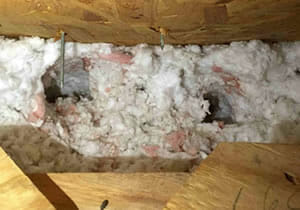
Rat Nests
Rats will shred attic insulation, cardboard and other soft items to make nests. Check in walls, chimneys, vents, attics, under eaves, and crawlspaces.
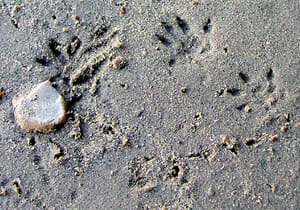
Rub Marks and Footprints
Rats have greasy fur that leave smudge marks on walls and surfaces as well as foot and tail marks in dusty areas of your home.
Rats are more selective than mice in where they go to the bathroom. They tend to go in one area that is hidden for hygienic reasons and also to avoid being discovered. Search behind appliances and in dark nooks of your attic
Signs of Squirrels in Your House
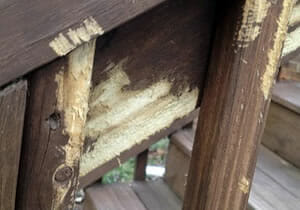
Chew Marks
Squirrels will also chew through materials, but be especially mindful of large holes in the exterior of your home that are chewed open by squirrels for entry points into your home. You’ll see damage to shingles, outer panels, eavestroughs, and along and around fascia boards and the roof line. Inside your home, look for wood chips in the attic, chewed out wires, insulation or air vent damage.
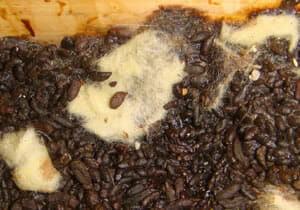
Squirrel Feces
Squirrel droppings can be hard to tell apart from large rat droppings.They’re about 3/8 inches long with round edges and will be scattered about. A pest control specialist will be able to tell the difference between squirrel feces and fecal matter from other rodents.
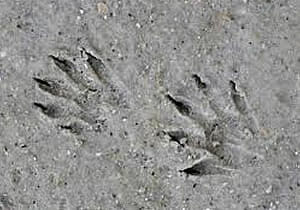
Squirrel Tracks
Squirrel pawprints are distinct and easy to pinpoint. Squirrels have four fingers on each front paw and five fingers on each hind paw, so you know you have squirrels if you see tiny repetitions of incongruent pawprints.
How to Get Rid of Mice, Rats, and Squirrels Inside Your Home
If there are signs of rodents in your home, there are several different trapping mechanisms that are highly rated. Once you’ve eliminated the rodents from your home and had it sanitized, it’s time to perform an exclusion, the process for safeguarding your home to keep nuisance animals out. The exclusion process is used to ensure rodents do not re-enter a home or even as a proactive measure for homeowners who have never had a pest problem and would like to keep it that way.
Here are the steps of an effective exclusion:
Identify all entry points: look around for holes around pipes, gutters, and siding.
Close all the holes in exterior and interior walls.
Cap your chimney if you have one.
Ensure all openings are no bigger than ¼ inch, especially around doors and windows.
Install self-closing devices in frequently used doors
Install rubber sweep seals under your garage door to eliminate gaps
Make sure seals around holes, pipes, and vents are tight.
Monitor old entry points and sealed holes regularly to ensure they are not being chewed through.
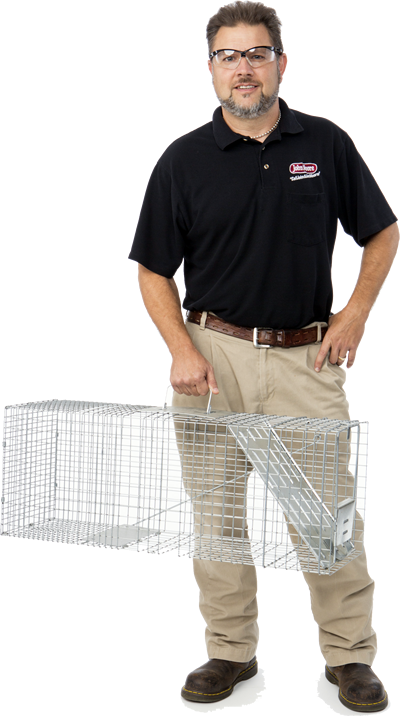
Even if you don’t have a rodent problem, a pest control specialist can provide preventative measures to keep your home free of infestation, disease, and damage, especially in preparation for the holidays when your focus should be on your guests – not pests.
Share this Post
